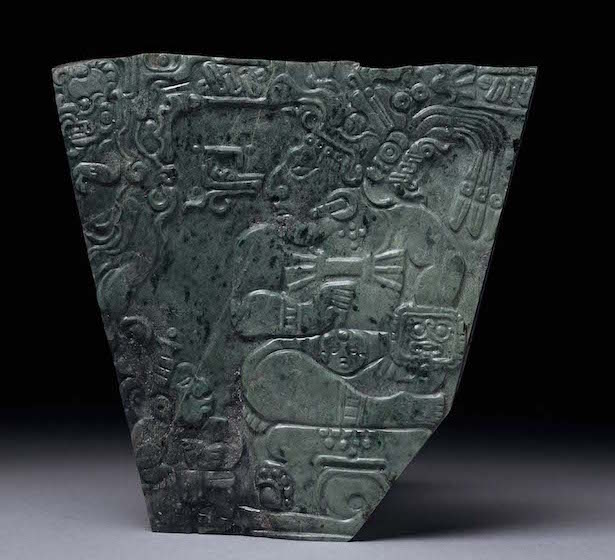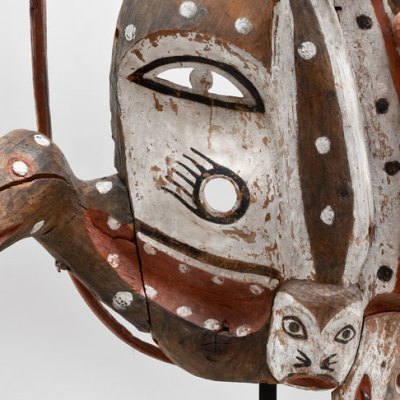Imagine a world where feathers were more valuable than gold. Fifteen hundred years ago, artists of Peru’s Nasca culture painstakingly knotted thousands of imported tropical feathers to strings, layering them thickly to create an exceptionally plush, luxurious garment of great power. For the Aztecs, who flourished in the lands that are now Mexico and Guatemala, feather-working was considered a higher status occupation than gold-working, and the rarest feathers, including the iridescent green feathers of the quetzal bird, were reserved for the Aztec emperor himself.
The exhibition ‘Golden Kingdoms: Luxury and Legacy in the Ancient Americas’ was inspired in part by this tension between what we now think of as inherent or universal value, and what was prized by the many civilisations that thrived in the Americas before the arrival of Europeans in the 16th century. Drawing upon recent archaeological findings and new investigations into the roles of artists, their patrons, and their workshops, the exhibition focuses on luxury arts in the lands between the two great imperial capitals of the ancient Americas: Cusco, the seat of the Inca state, and Tenochtitlan, the Aztec capital now buried under Mexico City.
Tabard with lizard-like creatures (500–750 AD), Nasca, Peru, South Coast. Virginia Museum of Fine Arts, Richmond

Most exhibitions of Pre-Columbian art have focused on a single culture, from a single modern nation. ‘Golden Kingdoms’, co-organised by the J. Paul Getty Museum, the Getty Research Institute, and the Metropolitan Museum of Art (where it travels next year from 27 February–28 May), is the result of an intensive four-year research effort that brought together art historians, archaeologists and conservators from across Latin America, Europe, and the United States. We gathered periodically in Lima, Los Angeles, and Mexico City to visit archaeological projects and study collections, and conducted additional research trips to Colombia, Ecuador, Guatemala, Nicaragua, and Panama.
The final selection of works includes over 300 objects gathered from 57 museums in 13 nations, including many that have been excavated in recent years, and others that have rarely, if ever, left their country of origin. Our intention is to provide a broader perspective which offers new ways of thinking about materials, luxury, and the visual arts, and to contribute crucial new insights into these works and the civilisations that produced them – including the newly understood prominence of high-status women across the ancient Americas.
The exhibition follows a specific historical and geographical path. It traces the development of gold-working in the Americas from its origins around 1000 BC in the Andes of South America, to its expansion northward into Central America, and finally to Mexico, where gold-working comes into its own only after 1000 AD. In the ancient Americas, artists and their patrons selected materials for luxury arts that could provoke a strong response – perceptually, sensually, and conceptually – and elevate the wearer and the beholder beyond the mundane. Metals such as gold and silver were used primarily for ritual and regalia, to express social status, political power, and religious beliefs rather than for tools, weapons, or currency. These and other materials used in luxury arts were also closely associated with the supernatural; they were thought to be embodiments of divine power, emitted, inhabited, or consumed by gods.
Jade plaque showing a seated king and palace attendant (600–800 AD), Maya, Mexico, Teotihuacan. British Museum, London

Although the spread northward of gold-working provides the exhibition with its trajectory and narrative, this golden road passed through regions where gold was of little interest to the indigenous populations. Jadeite, for example, was the ancient and enduring luxury material par excellence for the Olmecs and the Maya. Such variations bring to the fore the most challenging and broad-ranging question driving this project: how can we discern and interpret indigenous ideas of value? ‘Golden Kingdoms’ seeks to understand which materials were considered most precious to the Moche, the Incas, the Maya, the Aztecs, and other ancient American cultures, and how and why certain materials were selected and transformed into some of the ancient world’s most spectacular works of art.
Among the most fascinating works in the exhibition are those that began their lives in one part of the ancient Americas, only to be transported in ancient times to locations that are sometimes separated by thousands of miles, and hundreds of years, from where they were first created. Luxury arts, as traditionally defined, are not only of high value, they are also relatively small in scale and light in weight: qualities that make them worth transporting over great distances as royal gifts, trade items, or devotional offerings. An extraordinary Classic Maya jade plaque depicting a resplendent ruler seated on a throne, for example, probably carved in what is now Guatemala between 600 and 800 AD, ended up in the great central Mexican site of Teotihuacan, a city more than 600 miles away.
Over the course of the research, my co-curators, Timothy Potts, director of the Getty Museum, and Kim Richter, research specialist at the Getty Research Institute, and I came to understand that at its heart ‘Golden Kingdoms’ is about the exchange of ideas in both the present and the past. Through study and conversation with colleagues, we collectively came to a new understanding about the role of these works in the exchange of ideas across regions. A project such as ‘Golden Kingdoms’ allowed us to think about artistic exchange in the ancient Americas in a fresh way – unconstrained by today’s national boundaries – in the process revealing networks across what were once, and all too often now, considered separate traditions.
‘Golden Kingdoms: Luxury and Legacy in the Ancient Americas’ is at the Getty Center, Los Angeles, from 16 September–28 January 2018.
From the July/August 2017 issue of Apollo. Preview and subscribe here.


